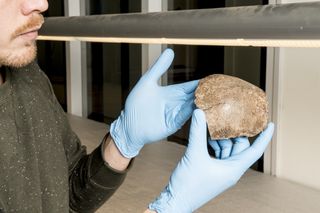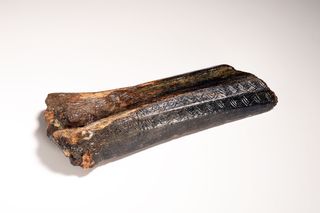Skull of 'Oldest Dutchwoman' Found Beneath the North Sea

Part of a prehistoric human skull and a bison bone decorated with a zigzag pattern — dubbed the world's "oldest Dutchwoman" and "oldest Dutch artwork" — have been revealed by scientists in the Netherlands, in research that highlights a sunken treasure trove of human archaeology beneath the North Sea.
Dutch fishermen found the partial skull and decorated bone on separate occasions in recent years, in parts of the submerged lands that linked continental Europe and the British Isles until about 9,000 years ago.
Both finds date from the end of the last ice age, around 13,000 years ago, when most of the North Sea was a vast plain of dry land up to 260 feet (80 meters) above sea level — a region scientists call Doggerland after the shallow fishing grounds of Dogger Bank between the Netherlands and the U.K. The grounds were named after the medieval Dutch fishing boats called doggers. [See Images of the Treasure Trove Found Beneath North Sea]
"These hunter-gatherers must have roamed these plains and perhaps one season they visited what is now the U.K. and the next season stayed in what are now the Netherlands," archaeologist Marcel Niekus told Live Science.
Niekus, who heads the archaeological Stone Foundation in the Netherlands, is one of the authors of new research, published in the journal Antiquitythis month, that details the ancient skull fragment and carved bison bone recovered from the North Sea.
"This now-submerged landscape is of crucial importance to our understanding of our past," Niekus said. "It is, so to speak, a treasure chest of archaeological finds."
Oldest Dutchwoman
The skull fragment was found near the Dutch coast in 2013. Scientist have used radiocarbon analysis to date the fragment to around 13,000 years ago, making it the oldest piece of bone from an early modern human found in the North Sea.
Sign up for the Live Science daily newsletter now
Get the world’s most fascinating discoveries delivered straight to your inbox.
Chemical analysis of the skull fragment — part of the left parietal bone, one of two rounded plates that form the dome of the skull — indicates that it came from a young or middle-age adult, between 22 and 45 years old, according to the new research.
The skull's shape suggests it probably came from a woman, although the researchers were unable to confirm the sex from the bone fragment.
The chemical analysis also confirmed that meat from hunted animals made up a significant part of the person's daily diet.
At the time, human hunter-gatherers were "pioneers" in the pine forests that spread over the now-submerged lands after the end of the last ice age, said archaeologist Luc Amkreutz of the Netherlands' National Museum of Antiquities, the lead author of the new research. [The 25 Most Mysterious Archaeological Finds on Earth]
As species like mammoths and woolly rhinoceros became extinct in the warming region, other animals such as elk, red deer, wild boar and some bison would have moved into the emerging forests, followed by early human hunters, Amkreutz told Live Science.
"It was a time of change, and these were the first new people that came with that change, true hunters of the forest," he said. "As the forests expanded farther north and west, so did our ancestors."
Oldest Dutch artwork
The decorated bison bone is slightly older than the human skull fragment — about 13,500 years old, the radiocarbon testing showed. Fishermen found the bone in the Brown Ridge area in 2005. It was then donated to the Netherlands' National Museum of Antiquities.

The carved zigzag pattern used to decorate the bone was characteristic of an abstract and geometric art style, attributed to the Federmesser culture of northwest Europe during the Late Paleolithic period (part of the Old Stone Age), said Niekus, who studied the prehistoric artwork for the new research.
"It has been suggested that the repetitive motifs have to do with streaming water, but another explanation, which we intend to explore further, is the fact that these zigzag patterns occur in [hallucinations] when shamans are in a trance,” Niekus said. "So, perhaps shamanism became more important during the Federmesser culture."
Similar zigzag decorations have been found on human-made artifacts from across Europe at that time — on the jawbone of a horse in the U.K., a deer antler from France and an elk antler from Poland, he said.
Such finds suggested that the different regions had a "shared symbolic vocabulary" that would have been understood by people over large parts of northwest Europe during the Late Paleolithic period, he said.
"We think this also means that there must have been quite intensive contacts over large areas," Niekus said. "People were very mobile in that period."
Original article on Live Science.
Tom Metcalfe is a freelance journalist and regular Live Science contributor who is based in London in the United Kingdom. Tom writes mainly about science, space, archaeology, the Earth and the oceans. He has also written for the BBC, NBC News, National Geographic, Scientific American, Air & Space, and many others.
Most Popular

